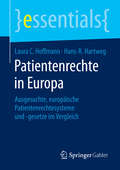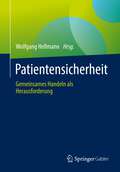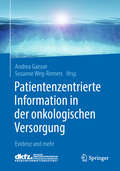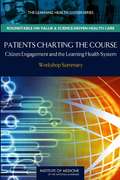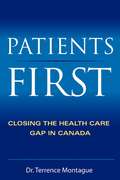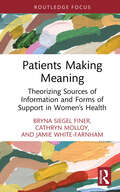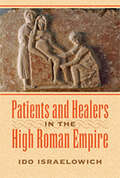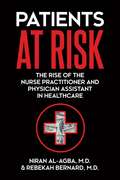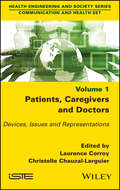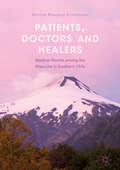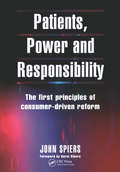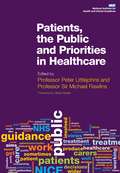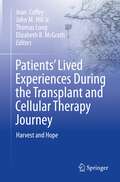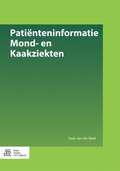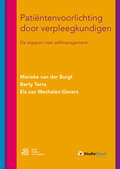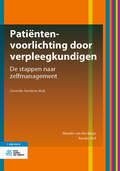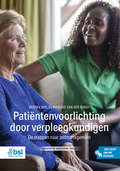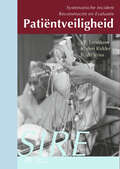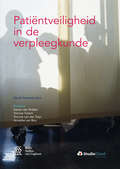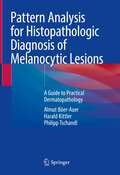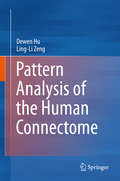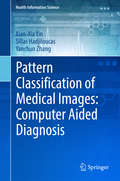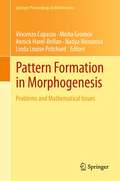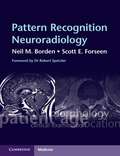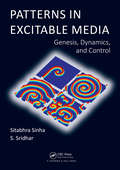- Table View
- List View
Patientenrechte in Europa: Ausgesuchte, europäische Patientenrechtesysteme und -gesetze im Vergleich (essentials)
by Hans-R. Hartweg Laura C. HoffmannLaura C. Hoffmann und Hans-R. Hartweg stellen auf Basis der Regelwerke ausgesuchter europäischer Nationen Vergleiche an, wie dort zum Schutz von Patientinnen und Patienten agiert wird. Nachdem in Deutschland das Patientenrechtegesetz verabschiedet wurde, das im Wesentlichen Patienten-Ansprüche in einer Rechtsgrundlage zusammenführt, ist eine Diskussion entbrannt, ob dieses Gesetz nicht eventuell zu kurz greift. Es kann dabei sinnvoll sein, den Blick auch über internationale Regeln schweifen zu lassen und einen Fokus auf Systeme zu legen, die auf historische oder institutionelle Entwicklungsverläufe schauen, die dem deutschen Gesundheitssystem ähneln. In einigen Nachbarstaaten sind entsprechende Patientenansprüche bereits tief verwurzelt und die Bürgerinnen und Bürger schauen auf eine lange Tradition entsprechender Regelwerke zurück.
Patientensicherheit: Gemeinsames Handeln als Herausforderung
by Wolfgang HellmannPatientensicherheit wird – auch im Kontext von Krisen wie Corona – zum beherrschenden Thema für die notwendige Neupositionierung des Gesundheitswesens in Deutschland. Dieses Buch setzt bei der Analyse der Rahmenbedingungen an und fokussiert auf einen ganzheitlichen Ansatz von Patientensicherheit unter Beteiligung von Versorgern, Vertretern der Gesundheitspolitik, der Ärzteschaft und den Krankenkassen, aber auch unter Einbindung von Patienten und Angehörigen. Es werden neue Versorgungskonzepte, innovative Managementstrategien sowie zielführende Instrumente zur Gewährleistung hoher Versorgungsqualität und Patientensicherheit vorgestellt. Zahlreiche Handlungsoptionen, Praxistipps und Fallbeispiele stellen den Praxisbezug zur Umsetzung insbesondere für die Ärzteschaft her. Ein Glossar mit wichtigen Begriffen, vor allem zur Information von Patienten und Personal der Versorgungseinrichtungen, rundet das Buch ab.
Patientenzentrierte Information in der onkologischen Versorgung: Evidenz und mehr
by Andrea Gaisser Susanne Weg-RemersAuf zahlreiche Fragen zu Krebsbehandlung und -versorgung und zum Leben mit Krebs, wie sie Patienten dem Onkologen oder dem Hausarzt stellen, finden sich in diesem Buch fundierte und detaillierte Antworten. Grundlage sind die Anfragen, mit denen sich Patienten und Fachleute an den Krebsinformationsdienst des Deutschen Krebsforschungszentrums wenden. Die Beiträge beschreiben zu den häufigsten Themen kurz den Sachverhalt, die praktische Relevanz und die Bedeutung für Patienten, fassen die Evidenzlage zusammen und zeigen Möglichkeiten zu einer an den Anliegen der Patienten orientierten, verständlichen Kommunikation auch bei „schwierigen“ Fragen auf. Zu jedem Kapitel sind weiterführende Informationen, auch für Patienten, und eine Literaturauswahl zusammengestellt. Eine Einführung zu den Herausforderungen der Informationsvermittlung und Kommunikation in der Onkologie und eine Auswahl nützlicher Hinweise und Empfehlungen für Informationssuche, Informationsbewertung und Kommunikation runden den Inhalt des Buches ab.
Patients Charting the Course
by The National Academy of SciencesAs past, current, or future patients, the public should be the health care system's unwavering focus and serve as change agents in its care. Taking this into account, the quality of health care should be judged not only by whether clinical decisions are informed by the best available scientific evidence, but also by whether care is tailored to a patient's individual needs and perspectives. However, too often it is provider preference and convenience, rather than those of the patient, that drive what care is delivered. As part of its Learning Health System series of workshops, the Roundtable on Value & Science-Driven Health Care hosted a workshop to assess the prospects for improving health and lowering costs by advancing patient involvement in the elements of a learning health system.
Patients First: Closing the Health Care Gap in Canada
by Terrence MontaguePATIENTS FIRST CLOSING THE HEALTH CARE GAP IN CANADA "This book is a must read for those who are interested in our health care system and who want to make it better. Dr. Montague provides an interesting overview of his journey through hospital wards, clinical trials, patient registries, patient health management and chronic disease management programs. Drawing on his diverse and unique background, he gives an important history of the past, analysis of the present and a glimpse of our future." --David Johnstone, MD President, Canadian Cardiovascular Society "Based on significant practice and research experience in the public, private and academic worlds, over many regions of Canada, Dr. Montague reveals to the reader, consumer, decision maker and patient an evolving and, until now, largely overlooked dimension in optimizing care and outcome. This optimization is important not only within the context of an individual's care, but within the scope of an entire practice, community or even nation." --Ross Tsuyuki, PharmD Director, The Epidemiology Coordinating and Research Centre, University of Alberta "Listen to Dr. Montague. He well understands both the problem and the solution, which is to pull out all the stops and to put patients first. He advocates patient health management to close the many care gaps. This will result in improved health for millions of Canadians and then, if we do it right, by emphasizing research and evidence-based health care and not merely budgets, our health care system will become more cost effective and our population healthier and more productive." --Mark Poznansky, PhD President, Robarts Research Institute
Patients Making Meaning: Theorizing Sources of Information and Forms of Support in Women’s Health (Routledge Studies in Rhetoric and Communication)
by Jamie White-Farnham Bryna Siegel Finer Cathryn MolloyThis book explores how women make meaning at various health flashpoints in their lives, overcoming fear, anxiety, and anger to draw upon self-advocacy, research, and crucial decision-making. Combining focus group research, content analysis, autoethnography, and textual inquiry, the book argues that the making and remaking of what we call “patient epistemologies” is a continual process wherein a health flashpoint—sometimes a new diagnosis, sometimes a reoccurrence or worsening of an existing condition or the progression of a natural process—can cause an individual to be thrust into a discourse community that was not of their own choosing. This study will interest students and scholars of health communication, rhetoric of health and medicine, women’s studies, public health, healthcare policy, philosophy of medicine, medical sociology, and medical humanities.
Patients and Healers in the High Roman Empire
by Ido IsraelowichA comprehensive study of both patients and healers in the High Roman Empire.Patients and Healers in the High Roman Empire offers a fascinating holistic look at the practice of ancient Roman medicine. Ido Irsaelowich presents three richly detailed case studies—one focusing on the home and reproduction; another on the army; the last on medical tourism—from the point of view of those on both sides of the patient-healer divide. He explains in depth how people in the classical world became aware of their ailments, what they believed caused particular illnesses, and why they turned to certain healers—root cutters, gymnastic trainers, dream interpreters, pharmacologists, and priests—or sought medical care in specific places such as temples, bath houses, and city centers. The book brings to life the complex behavior and social status of all the actors involved in the medical marketplace. It also sheds new light on classical theories about sickness, the measures Romans undertook to tackle disease and improve public health, and personal expectations for and evaluations of various treatments. Ultimately, Israelowich concludes that this clamoring multitude of coexisting forms of health care actually shared a common language. Drawing on a diverse range of sources—including patient testimonies; the writings of physicians, historians, and poets; and official publications of the Roman state—Patients and Healers in the High Roman Empire is a groundbreaking history of the culture of classical medicine.
Patients at Risk: The Rise of the Nurse Practitioner and Physician Assistant in Healthcare
by Niran (Rebekah) Al-Agba (Bernard)Patients at Risk: The Rise of the Nurse Practitioner and Physician Assistant in Healthcare exposes a vast conspiracy of political maneuvering and corporate greed that has led to the replacement of qualified medical professionals by lesser trained p
Patients, Caregivers and Doctors: Devices, Issues and Representations
by Laurence Corroy Christelle Chauzal-LarguierThis book studies the way chronic and long-term illnesses are represented in media, and the issues and structures associated with them. It also examines the way in which patients define themselves, the relationships they form with their carers and the experiences of these carers themselves.The way in which the figure of the caregiver can be portrayed as a necessary support for the patient is also discussed. Testimonies from digital platforms, fictional universes, examples from everyday life and from public and private organizations provide insight into the relationships between patients, caregivers and carers.
Patients, Doctors and Healers
by Dorthe Brogård KristensenRecognizing the interplay between biomedicine and indigenous medicine among the Mapuche in Southern Chile, this book explores notions of culture and personhood through the bodily experiences and medical choices of patients. Through case studies of patients in the context of medical pluralism, Kristensen argues that medical practices are powerful social symbol indicative of overarching socio-political processes. As certain types of extreme and violent experiences–known as olvidos–lack a framework that allows them to be expressed openly, they therefore surface as symptoms of an illness, often with no apparent organic pathology. In these contexts, indigenous medicine, thanks to its sensitivity to socio-political contexts, provides a space for articulation and management of collective experiences and suffering among patients in Southern Chile.
Patients, Power and Responsibility: The First Principles of Consumer-Driven Reform
by John SpiersCare pathways are being developed throughout the health service to improve the quality and effectiveness of care. Are they being developed efficiently and making the most of the latest clinical computing systems? This is the first practical guide on how Information Technology and systems methods can support the development implementation and maintenance of "e-Pathways". Case studies throughout highlight team approaches to facilitation clinical knowledge management process analysis and redesign and computerisation - providing insights into how e-Pathways can be used to support high quality patient care. The information is presented in an easy-to-read style and requires no prior knowledge of IT systems. Doctors nurses and managers throughout primary and secondary care as well as healthcare information technology specialists and suppliers will find this to be essential reading. An accompanying CD-ROM includes supplementary information providing useful website links and additional material on specific topic areas.
Patients, the Public and Priorities in Healthcare (Radcliffe Ser.)
by Peter Littlejohns Michael RawlinsSharing the costs of ill health is the mark of a civilised society. However, every society has limited healthcare resources, and must therefore make finely balanced decisions on how best to allocate them. The National Institute for Health and Clinical Excellence (NICE) has been responsible for the UK's health resource allocation for a decade. To inform its decisions, a Citizens Council of 30 members of the general public was established by NICE to gauge the underlying values of the society it serves. A number of national and international organisations and governments have asked NICE to share its experiences in establishing and running the Citizens Council, and encouraging and supporting patient involvement. As part of NICE's response, this book provides an up to date 'position statement' on the Citizens Council, an exploration of how patients interact with NICE and how their views are taken into account, and a national and international perspective on new issues facing the interaction between patients, the public and healthcare provision. 'Reading this volume will enable you, the reader, to assess how well NICE is acting as a means of fostering responsible public choice. I hope you profit from its chapters as much as I have.' - Albert Weale in his Foreword
Patients’ Lived Experiences During the Transplant and Cellular Therapy Journey: Harvest and Hope
by Thomas Long Jean Coffey John M. Hill Elizabeth B. McGrathThe book was envisioned by bedside nurses caring for transplant and cellular therapy patients as a way to teach novice nurses and health care colleagues about the care required for this complex patient population. The nurse authors recruited an oncology nurse practitioner, transplant physician, nurse scientist and expert in medical humanities and health studies to join the project team. The dedication of the team and the willingness of the patients to contribute to the project, has led to a unique case study approach focused on the lived experience of patients and care partner(s) during the transplant/cellular therapy journey. The case studies are unique in that they encompass a qualitative narrative developed using Interpretive Phenomenological Analysis (IPA) and the inclusion of the individual's actual medical and nursing care from their health record. At every step along the trajectory of the illness, the medications and care received are described, interspersed with the voice of the patient and care partner(s) sharing their experiences. The chapters follow the individual patients and their care partner(s) through all phases of their illness. The interviews were conducted, and case studies written by the bedside clinical nurses. Visual art and prose created by patients and care partner(s)s are included in the chapters. The book also includes an introduction written by the nurse authors, a methods chapter on the inclusion of IPA in a case study, and poignant epilogue. The premise of nursing support for survivorship is woven throughout the book, highlighting how giving back aids in recovery identity.This book, full of beautiful artworks and poems, is the work of clinical nurses devoted to improving care for their patients by sharing the patient stories with others. It introduces a unique approach to the case study which could be replicated and applied to any diagnosis.
Patiënteninformatie Mond- en Kaakziekten
by Isaäc van der WaalAandoeningen in en rond de mond komen onder meer voor op het mondslijmvlies, de speekselklieren, in het kaakbot, op de tong, het gehemelte en de lippen. Door deze verscheidenheid vormen deze aandoeningen het werkterrein van zowel tandartsen, huisartsen, mondhygiënisten als specialisten. Deze Atlas mond- en kaakziekten biedt de patient een overzicht van de meest voorkomende aandoeningen in mondgebied.
Patiëntenvoorlichting door verpleegkundigen
by Berty Terra Marieke van der Burgt Els van Mechelen-GeversVan patiënten wordt steeds meer zelfmanagement verwacht. Maar als verpleegkundige interventie is patiëntenvoorlichting en ondersteuning van zelfmanagement vaak weinig concreet uitgewerkt. Patiëntenvoorlichting door verpleegkundigen. De stappen naar zelfmanagement biedt hulp.Ondersteuning van zelfmanagement wordt steeds belangrijker voor de verpleegkundige en de praktijkondersteuner in de huisartsenpraktijk. Samenwerking en gezamenlijke besluitvorming vormen de basis voor daarvoor. De in dit boek geïntroduceerde praktische stappenreeks van gedragsverandering (openstaan - begrijpen - willen - kunnen - doen - blijven doen) bevordert een methodische aanpak bij de voorlichting en ondersteuning van zelfmanagement bij persoonsgerichte zorg. Nieuw in deze herziene uitgave is de nadruk op ondersteuning van zelfmanagement van chronisch zieken op basis van het zogeheten chronischezorgmodel. Daarnaast is er aandacht voor voorlichting aan mensen met beperkte taal- en informatievaardigheden en bevat het boek video's van voorlichtings- en ondersteuningsgesprekken. Tot slot bevat het boek toegepaste theorie met voorbeelden uit de verpleegkundige praktijk. Dit boek is bestemd voor studenten verpleegkunde (hbo-v), studenten verpleegkundige vervolgopleiding, verpleegkundigen, praktijkondersteuners, nurse practitioners, verpleegkundig specialisten. Marieke van der Burgt is docent aan de opleiding verpleegkunde van het Rijn IJssel in Arnhem, publicist en trainer patiëntenvoorlichting. Berty Terra heeft een jarenlange ervaring als docent psychologie/agogiek en trainer patiëntenvoorlichting en gespreksvaardigheden aan Fontys Hogeschool Eindhoven. Els van Mechelen-Gevers heeft een jarenlange ervaring als docent aan de opleiding verpleegkunde en is momenteel werkzaam als publicist op het gebied van gezondheidskunde en patiëntenvoorlichting.
Patiëntenvoorlichting door verpleegkundigen: De stappen naar zelfmanagement
by Marieke van der Burgt Renske MolOndersteuning van zelfmanagement wordt steeds belangrijker voor de verpleegkundige en de praktijkondersteuner in de huisartsenpraktijk. Patiëntenvoorlichting door verpleegkundigen. De stappen naar zelfmanagement biedt een methodische aanpak van voorlichting, gezamenlijke besluitvorming en ondersteuning van zelfmanagement bij persoonsgerichte zorg. De stappenreeks van gedragsverandering (openstaan – begrijpen – willen – kunnen – doen – blijven doen) is daarbij een praktisch handvat. Het boek sluit aan bij Bachelor of Nursing 2020 en de daarin uitgewerkte CanMeds-rollen. Nieuw in deze uitgave is de zelfmanagementondersteuning die aansluit bij het concept ‘positieve gezondheid’. Patiëntenvoorlichting en zelfmanagementondersteuning worden besproken in het licht van het chronischezorgmodel, maar ook de klinische zorg en herstelondersteunende zorg in de ggz komen aan bod. Ook is er aandacht voor voorlichting aan mensen met beperkte gezondheidsvaardigheden. Het boek bevat toegepaste theorie die wordt toegelicht met voorbeelden uit de verpleegkundige praktijk. Aan het boek zijn interactieve gesprekssimulaties toegevoegd als oefenmateriaal. Ook zijn er video’s van voorlichtings- en ondersteuningsgesprekken. Dit boek is bestemd voor studenten verpleegkunde (hbo-v), studenten verpleegkundige vervolgopleiding, verpleegkundigen, praktijkondersteuners, nurse practitioners, verpleegkundig specialisten.
Patiëntenvoorlichting door verpleegkundigen: De stappen naar zelfmanagement
by Marieke van der Burgt Renske MolOndersteuning van zelfmanagement wordt steeds belangrijker voor de verpleegkundige. Patiëntenvoorlichting door verpleegkundigen. De stappen naar zelfmanagement biedt een methodische, persoonsgerichte aanpak van voorlichting, en ondersteuning van zelfmanagement. De stappenreeks van gedragsverandering (openstaan – begrijpen – willen – kunnen – doen – blijven doen) is daarbij een praktisch handvat. Het boek sluit aan bij Bachelor of Nursing 2030 en de CanMeds-rollen. Voorlichting wordt uitgewerkt vanuit het concept &‘positieve gezondheid&’ en samen beslissen. In dit boek ligt het accent op mensen met chronische gezondheidsproblemen. Daarnaast is er is aandacht voor mensen met beperkte gezondheidsvaardigheden, communicatie bij e-health en preventie. Theorie van gedragsverandering is gekoppeld aan praktijkvoorbeelden. De communicatieve skills bij de stappen kunnen worden ingezet bij gesprekken over gedragsverandering, slecht nieuws en rouw en samen beslissen. Ook motiverende gespreksvoering komt aan bod. Studenten kunnen oefenen aan de hand van interactieve gesprekssimulaties. Er zijn video&’s van voorlichtings- en ondersteuningsgesprekken. Ter ondersteuning van docenten en studenten zijn samenvattingen en leerdoelen toegevoegd. Dit boek is bestemd voor studenten verpleegkunde (hbo-v), studenten verpleegkundige vervolgopleiding, verpleegkundigen, praktijkondersteuners, nurse practitioners, verpleegkundig specialisten. Renske Mol is docent gespreksvaardigheden aan de opleiding HBO-verpleegkunde Fontys Hogeschool Eindhoven. Daarnaast geeft zij trainingen op het gebied van communicatie, stress-sensitief werken en ervaringsdeskundigheid. Marieke van der Burgt is auteur van boeken over patiëntenvoorlichting en de gezondheidszorg.
Patiëntveiligheid
by I. P. Leistikow K. Ridder Den B. Vries DeDe auteurs hebben in Patiëntveiligheid, Systematische Incident Reconstructie en Evaluatie (SIRE) de ervaringen verwerkt die zij hebben opgedaan bij het uitvoeren van, en onderwijs geven in, SIRE. Daarnaast is de scoop verbreed met voorbeelden uit de huisartsenpraktijk, GGZ en care sector.
Patiëntveiligheid in de verpleegkunde
by Karien Ridder Yvonne Asten Yvonne Tuijn Annelies BonDit boek biedt de nodige basiskennis over patiëntveiligheid voor verpleegkundigen en andere zorgprofessionals die betrokken zijn bij de directe patiëntenzorg. Het is opgebouwd uit drie delen. Deel 1 bespreekt de systeembenadering. Waar liggen de risico’s en wat kun je doen om het zelf als verpleegkundige veiliger te maken voor je patiënten? In dit deel is een nieuw hoofdstuk over Patiëntveiligheid in België opgenomen. Deel 2 geeft inzicht in het MOTTO-model (voorheen het SEIPS-model). MOTTO staat voor de structuur Mens, Organisatie, Taak, Techniek en Omgeving. Deel 3 behandelt de specifieke zorg vanuit verschillende perspectieven, bijvoorbeeld de zorg op de ok, de polikliniek, de thuiszorg en de psychiatrie. In Nederland is de afgelopen jaren veel geïnvesteerd om de zorg veiliger te maken. De WHO heeft Patiëntveiligheid hoog op haar lijst staan omdat onveiligheid in de zorg veel schade berokkent. Het kan zelfs leiden tot overlijden en beschadiging van patiënten. Veilige zorg begint bij de directe zorg rond het bed. Voor het onderwijs aan alle zorgprofessionals zijn patiëntveiligheidscompetenties ontwikkeld die in dit boek zijn vertaald naar praktisch verpleegkundig handelen. Diverse casussen helpen dit te visualiseren. Patiëntveiligheid in de verpleegkunde is bestemd voor verpleegkundigen in de zorg, zowel intramuraal (ziekenhuizen, zorginstellingen, psychiatrie) als extramuraal (huisarts, thuiszorg) of in opleiding op hbo- en mbo-niveau. Het volledige boek is ook digitaal beschikbaar met samenvattingen en toetsvragen per hoofdstuk en interessante en verdiepende links. De redactie bestaat uit: Karien den Ridder, Yvonne Tuitert, Yvonne van der Tuijn en Annelies van Bon. Aan deze druk hebben bijna vijftig professionals meegewerkt, die allen werkzaam zijn in de zorg en daar veel te maken krijgen met patiëntveiligheid in hun specifieke werkgebied. De auteurs kennen de dagelijkse werkelijkheid en zien het als een grote uitdaging hun bijdrage te leveren aan een veiligere patiëntenzorg.
Pattern Analysis for Histopathologic Diagnosis of Melanocytic Lesions: A Guide to Practical Dermatopathology
by Almut Böer-Auer Harald Kittler Philipp TschandlPattern analysis is a powerful method that changed dermatopathology, nowadays an indispensable tool in the diagnostic workup of inflammatory and neoplastic lesions. The diagnosis of melanocytic lesions can also be mastered by pattern analysis, which is the link between pathology, dermatoscopy, and clinical dermatology and supports the integration of all views. The histopathologic diagnosis of melanocytic lesions can be challenging for novices and experts alike. While classifications of melanocytic lesions come and go, pattern analysis is timeless; it can be assigned to any classification, current or future, and provides a framework that allows to address complex and uncertain cases in a repeatable manner. While uncertainty cannot be totally eliminated, pattern analysis helps to express this uncertainty in a meaningful way. Written by expert dermatopathologists with experience in dermatoscopy, this book is dedicated to young colleagues and to those who have not yet settled on one of the competing schools of thought; it is intended as a practical guide to help making correct observations, to describe them with a well-defined terminology, and to yield critical decisions in the face of incomplete or conflicting information. The illustrations contained in the volume are all original pictures in high-quality and full-color: reproductions of histopatological cuts in low and high magnification will assist pathologists, dermatologists, and dermatopathologists in interpreting histological slides of melanocytic skin lesions.
Pattern Analysis of the Human Connectome
by Dewen Hu Ling-Li ZengThis book presents recent advances in pattern analysis of the human connectome. The human connectome, measured by magnetic resonance imaging at the macroscale, provides a comprehensive description of how brain regions are connected. Based on machine learning methods, multiviarate pattern analysis can directly decode psychological or cognitive states from brain connectivity patterns. Although there are a number of works with chapters on conventional human connectome encoding (brain-mapping), there are few resources on human connectome decoding (brain-reading). Focusing mainly on advances made over the past decade in the field of manifold learning, sparse coding, multi-task learning, and deep learning of the human connectome and applications, this book helps students and researchers gain an overall picture of pattern analysis of the human connectome. It also offers valuable insights for clinicians involved in the clinical diagnosis and treatment evaluation of neuropsychiatric disorders.
Pattern Classification of Medical Images: Computer Aided Diagnosis
by Yanchun Zhang Xiao-Xia Yin Sillas HadjiloucasThis book presents advances in biomedical imaging analysis and processing techniques using time dependent medical image datasets for computer aided diagnosis. The analysis of time-series images is one of the most widely appearing problems in science, engineering, and business. In recent years this problem has gained importance due to the increasing availability of more sensitive sensors in science and engineering and due to the wide-spread use of computers in corporations which have increased the amount of time-series data collected by many magnitudes. An important feature of this book is the exploration of different approaches to handle and identify time dependent biomedical images. Biomedical imaging analysis and processing techniques deal with the interaction between all forms of radiation and biological molecules, cells or tissues, to visualize small particles and opaque objects, and to achieve the recognition of biomedical patterns. These are topics of great importance to biomedical science, biology, and medicine. Biomedical imaging analysis techniques can be applied in many different areas to solve existing problems. The various requirements arising from the process of resolving practical problems motivate and expedite the development of biomedical imaging analysis. This is a major reason for the fast growth of the discipline.
Pattern Formation in Morphogenesis
by Vincenzo Capasso Annick Harel-Bellan Misha Gromov Linda Louise Pritchard Nadya MorozovaPattern Formation in Morphogenesis is a rich source of interesting and challenging mathematical problems. The volume aims at showing how a combination of new discoveries in developmental biology and associated modelling and computational techniques has stimulated or may stimulate relevant advances in the field. Finally it aims at facilitating the process of unfolding a mutual recognition between Biologists and Mathematicians of their complementary skills, to the point where the resulting synergy generates new and novel discoveries. It offers an interdisciplinary interaction space between biologists from embryology, genetics and molecular biology who present their own work in the perspective of the advancement of their specific fields, and mathematicians who propose solutions based on the knowledge grasped from biologists.
Pattern Recognition Neuroradiology
by Scott E. Forseen Neil M. BordenFaced with a single neuroradiological image of an unknown patient, how confident would you be to make a differential diagnosis? Despite advanced imaging techniques, a confident diagnosis also requires knowledge of the patient's age, clinical data and the lesion location. Pattern Recognition Neuroradiology provides the tools you will need to arrive at the correct diagnosis or a reasonable differential diagnosis. This user-friendly book includes basic information often omitted from other texts: a practical method of image analysis, sample dictation templates and didactic information regarding lesions/diseases in a concise outline form. Image galleries show more than 700 high quality representative examples of the diseases discussed. Whether you are a trainee encountering some of these conditions for the first time or a resident trying to develop a reliable system of image analysis, Pattern Recognition Neuroradiology is an invaluable diagnostic resource.
Patterns in Excitable Media: Genesis, Dynamics, and Control
by S. Sridhar Sitabhra SinhaExcitable media comprise a class of models for a wide range of physical, chemical, and biological systems that exhibit spontaneous formation of spatial patterns. Patterns in Excitable Media: Genesis, Dynamics, and Control covers recent developments in the interdisciplinary field of dynamics and control of patterns in nonlinear biological systems described by excitable media models. Using examples of many real-life systems, it explores the impact of pattern dynamics on the structural and functional heterogeneities in the system. The book also discusses low-amplitude control schemes for eliminating patterns from an excitable medium, such as life-threatening cardiac arrhythmia. Codes for numerical simulation are provided in the appendix.
